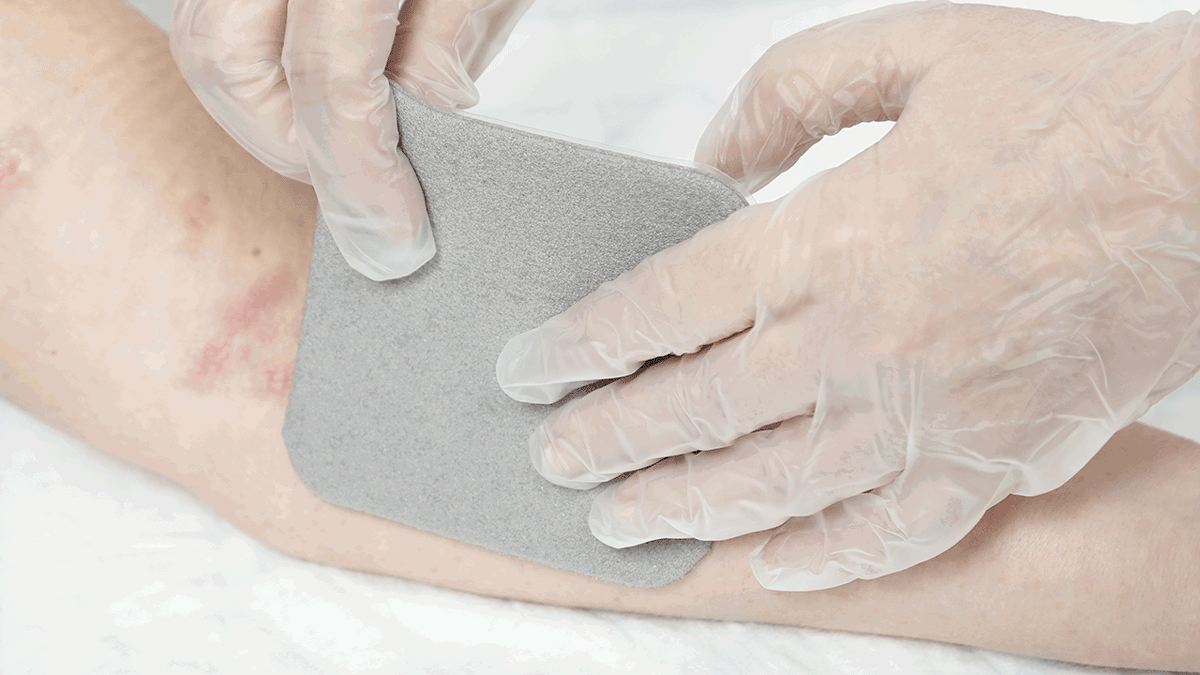Better wound care with less resources
Making wound care more sustainable is not just about using more sustainable materials or producing products in more resource efficient ways. To truly revolutionise wound care, we also need to make the products and the treatments more efficient. So that we can achieve more with less. Only then can we free patients, healthcare professionals, hospitals, and the planet from the burden of wounds.
The most sustainable dressing is the one you did not have to use
At Mölnlycke we develop advanced wound dressings that allow considerably longer wear time – and help the body accelerate healing. We also focus heavily on innovative solutions that prevent wounds, skin damage or surgical site complications from occurring in the first place. So that you can use fewer dressings, but better.
In parallel we explore new, more accessible and intuitive ways of diagnosing and treating wounds, that help transform the care delivery, empowering patients while easing the pressure on caregivers and healthcare providers.

"At Mölnlycke we want to empower patients and protect our planet by leading the change in sustainability. As a world-leading wound care company, it is our responsibility to innovate solutions for better quality of life while minimising environmental impact."
Anders Andersson EVP Wound Care
But our commitment doesn’t end there. We partner up with our clients to support in developing progressive sustainability strategies as well as in improving protocols and pathways of care. Because dressing choice matters. And by using them in the right way at the right time, we can create an even bigger impact.
The outcome is more satisfied patients, that can be discharged earlier, reduced suffering, fewer dressing changes, improved staff wellbeing, and less waste. All of which contributes to saving time and money, while reducing the environmental impact of wound care.

From three dressing changes to none, with Mepilex® Border Post-Op
Using conventional dressings and outdated protocols lead to frequent sterile dressing changes, each typically requiring¹:
- sterile dressing
- hand wash/alcohol hand wash
- non-sterile gloves
- apron
- small sterile drape
- wound cleanser (if required)¹
This generates a great deal of waste, that could be reduced if dressings were changed less frequently.
The solution
Mepilex Border Post-Op is designed and proven to be safe to use for up to 14 days². Since sutures or staples are generally removed from the wound at around 14 days, Mepilex Border Post-Op may require no dressing changes, compared to at least three changes for conventional dressings.
The outcome
A dramatic reduction in medical waste (packaging and consumables) and in greenhouse gas emissions related to waste disposal.

Reducing medical waste in burns treatment with Mepilex® Ag
When treating burns with SSD and gauze, the required daily dressing change consume at least³:
- sterile dressing
- hand wash/alcohol hand wash
- non-sterile gloves
- apron
- small sterile drape
- wound cleanser (if required)⁴
This generates a great deal of waste, that could be reduced if dressings were changed less frequently.
The solution
Mepilex Ag can be used for up to 7 days⁴ before it needs to be changed. Studies comparing the number of dressing changes for Mepilex Ag with silver sulfadiazine dressings found that Mepilex Ag resulted in significantly fewer dressing changes:
- From 12.4 to 2.2⁵
- From 13.0 to 3.0⁶
The outcome
A reduction in the number of dressing changes by 79% or more with Mepilex Ag, leading to a similar reduction in medical waste (packaging and consumables) and in greenhouse gas emissions related to waste disposal.

Preventing pressure injuries with Mepilex® Border Sacrum
Hospital-acquired pressure injuries account for 25% of all “wasteful spending” related
to failures in health care. Studies show that more than one in ten hospitalised patients suffer from a pressure injury⁷. It can take from several months to several years to treat a pressure injury⁸, which means hundreds of dressing changes, causing high levels of:
- greenhouse gas (GHG) emissions from medical devices, hand cleansing solutions and antimicrobial therapy used
- medical waste
- additional GHG emissions resulting from nurses commuting to patient homes.
The solution
Using Mepilex® Border Sacrum to prevent pressure injuries can reduce GHG emissions and medical waste from the use of bordered foam dressings alone by 3.3 times, with further GHG emissions saved by reducing the need for other forms of treatment.
The outcome
Preventing pressure injuries reduces environmental impact by reducing:
- number of dressings required
for treatment - use of dressing-change-related products
- lengths of stay in hospital (potentially)
- nurse commutes to patient homes

Fewer dressing changes and less waste with Mepilex® Border Flex
Some bordered foam dressings require frequent sterile dressing changes, each typically requiring⁹:
- sterile dressing
- hand wash/alcohol hand wash
- non-sterile gloves
- apron
- small sterile drape
- wound cleanser (if required)⁹
This generates a great deal of waste that could be reduced if dressings were changed less frequently.
The solution
Mepilex Border Flex has been designed and proven to stay on longer and shows greater compliance with seven-day wear time protocol¹⁰. Since significantly (up to 78%)¹¹ fewer dressings are required, dressing change related waste can be significantly reduced, according to a QIP.
The outcome
A dramatic reduction in medical waste (packaging and consumables) and in greenhouse gas emissions related to waste disposal.

WeCare
Our commitment as a company
At Mölnlycke, our ambition is to transform our business to become a global leader in sustainable healthcare. Inspired by our purpose to revolutionise care for people and planet, our sustainability roadmap to 2030, WeCare, guides us and lends structure to our sustainability efforts.
-
References
- Pickering D, Marsden J. Techniques for aseptic dressing and procedures. Community Eye Health. 2015;28(89):17.
- Van Overscheide P, Sinnaeve F, Lapierre C, Pauwels A, Alam K, Sandy-Hodgetts K. A single-centre retrospective study investigating patient-reported outcomes of extended dressing wear time for incisional healing following orthopaedic surgery: the ARCTIS study. Journal of Wound Care. ISWCAP suppl. 2024; 33(8): S17–S26.
- Pickering D, Marsden J. Techniques for aseptic dressing and procedures. Community Eye Health. 2015;28(89):17.
- IFU Mepilex Ag
- Silverstein P, Heimbach D, Meites H et al. An open, parallel, randomized, comparative, multicenter study to evaluate the cost-effectiveness, performance, tolerance, and safety of a silver containing soft silicone foam dressing (intervention) vs silver sulfadiazine cream. J Burn Care Res 2011, 32(6): 617-626
- Tang H, Lv G, Fu J et al. An open, parallel, randomized, comparative, multicenter investigation evaluating the efficacy and tolerability of Mepilex Ag versus silver sulfadiazine in the treatment of deep partial-thickness burn injuries. J Trauma Acute Care Surg 2015, 78(5): 1000-1007
- Palmer K, Hill J, Clegg A, One in 10 hospitalised patients have a pressure injury worldwide, Evidence-Based Nursing 2021;24:93.
- National Pressure Ulcer Advisory Panel (NPUAP), Prevention and Treatment of Pressure Ulcers: Clinical Practice Guideline, 2019, available from: https://www.npuap.org/
- Pickering D, Marsden J. Techniques for aseptic dressing and procedures. Community Eye Health. 2015;28(89):17.
- Alvarez, O.M., Granick, M.S., Reyzelman, A., Serena, T. A prospective, randomized, controlled, crossover study comparing three multilayered foam dressings for the management of chronic wounds. Journal of Comparative Effectiveness Research 2021 doi:10.2217/cer-2020-0268
- Tyson, L. Study First: Driving the Case for Improving Hospital Wound Care. Poster Presentation at WOCN Annual Meeting, Nashville, 2019.



